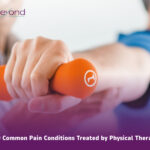Whether you are in your first, second or third trimester seeing a physical therapist during pregnancy can be beneficial for both mom and baby.
The female body undergoes dramatic changes throughout pregnancy. As a physical therapist, I treat expecting moms throughout all phases of pregnancy. One of the major hormones responsible for these changes is called relaxin. It is released throughout pregnancy and is responsible for relaxing the ligaments allowing the female pelvis, rib cage and spine to adapt and change as the baby grows and develops inside of her. Because of this, the baby’s position and size also contributes to increased stress and strain on mom’s body as she gets closer and closer to the due date. Because moms to be experience this relaxation of ligaments, pregnancy physical therapy can be extremely helpful as it is important to maintain a good balance of strength, endurance and flexibility providing her body the support she needs both before and after the baby is born as she has to start lifting, carrying and feeding her newborn.
It is never too late to address any aches and pains during and after pregnancy.
I have commonly treated women who are pregnant, or are months or years post-partum who continue to experience aches and pains that all started when carrying their babes. Take action and see a physical therapist if you have had or are currently experiencing any of the following:
Diastasis Recti:
Expectant moms are prone to a separation of the main abdominal muscle, the rectus abdominus (aka “six pack muscle”). Abdominal stretching has to occur in order to create space for her growing uterus and baby. This is more common among moms who are > 33 years old, are expecting multiples, had great weight gain during pregnancy, or had a previous c-section.
If you have or know someone who has experienced this keep in mind:
Lifting mechanics, twisting activities, strengthening, and avoid using the valsava maneuver (holding your breath as you exert effort). Getting properly assessed by a physical therapist can help prevent and/or help during and especially after pregnancy making sure you are utilizing your muscles appropriately utilizing a variety of techniques and exercises.
Pregnant and Swollen:
Swelling is bound to happen, especially in the later stages of pregnancy. Swelling usually occurs in the legs, but it can occur throughout the body. If you or someone you know is experiencing swelling in the face and hands this may be one of the signs of preeclampsia. In that case, check in with your doctor. For general leg swelling elevate your legs, use cold compresses, wear support stockings and stay hydrated.
Round Ligament Pain:
The Round ligament stretches during pregnancy as the uterus gets bigger. This ligament anchors the uterus to the pelvic bone. When it stretches, it can cause belly pain, asymmetrical leg length, and possible swelling in the same leg. It can also cause swelling asymmetrically in the affected leg. Be aware of pain in the lower abdominal quadrant. If the pain gets severe, make sure to follow up with your doctor to rule out other possibilities such as appendicitis or a hernia. If it is true round ligament pain, it can be addressed with a visit to a women’s health physical therapist during pregnancy to help manage such symptoms and prevent them from worsening.
Back pain:
There is a natural curve of the spine that gets exaggerated during pregnancy as ligaments stretch and belly expands. These changes create added stress on an expectant mom’s lower back. Back pain can also be the result of asymmetrical leg length due to excess motion in the pelvis. This too is a side effect of stretched ligaments creating more space for the baby. Wearing a sacroiliac belt during pregnancy can help stabilize the pelvis while taking pressure off the back providing pain relief. Strengthening the abdominal and pelvic floor muscles are also essential in preventing and helping back pain during and after pregnancy.
Nerve Pain:
Because of the postural changes, increased ligament laxity and swelling, nerves can get aggravated if stretched or compressed during pregnancy. Sometimes the baby’s position can also affect the health of a nerve. The sciatic nerve will commonly be compressed, as the baby can sit on it. Other nerves in the front or side of the hip and thigh as well as in the groin can also get compressed from a mom’s growing belly or from carrying an older sibling on her hip. Some of these symptoms will go away once the baby is born, however, proper nerve mobility is also important for overall quality of life while pregnant. Unique techniques and treatments can be implemented by a physical therapist to help maintain the health of such nerves.
Neck pain:
There is an increase forward head posture placing excess strain on the muscles in the front of the neck also contributing to headaches. Rather than loosening the neck muscles, address the stiffness and tightness in the middle and upper back that comes with pregnancy can help take pressure off the neck and shoulders. Using a foam roller or an exercise ball with proper instruction to help open your middle back and chest muscles can not only be relaxing but can also help decrease the strain on both the neck and lower back.
It is amazing how women adapt and evolve while experiencing significant shifts in hormone levels, metabolism, circulation, and of course physicality. Most women are known for their sixth sense and intuition, if your body is telling you something, listen to it and have it addressed. You and your baby will be thankful.
















